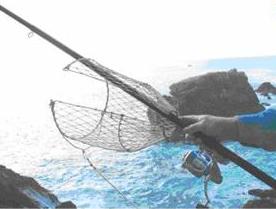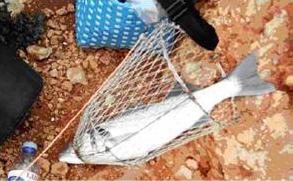Fishing Gears and Materials
Recreational Fishing
Fishing Gears and Materials
Breadcrumbs
- Fisheries
- Fisheries
- Recreational Fishing
- Applicable Rules
- Fishing Gears and Materials
![]() Definitions / Characteristics of Fishing Gear and Materials
Definitions / Characteristics of Fishing Gear and Materials
(See articles 2 and 3 of Ordinance No. 14/2014 of 23th January)
Fishing gear
- Hand line - Consists of a line in which can be placed up to nine hooks, which is operated manually (It is linked to the practitioner's hand). Other material (buoys, fishing weights, etc.) may also be attached as long as they do not allow the capture of species by direct action. Each recreational fisherman may use up to three hand lines and may not use more than nine hooks.
- Fishing rod - Line with single or multiple hooks, which is operated by means of a cane or rod, equipped or not with a drum or reel.
- Trolling - A hook consisting of a single line with up to three hooks or samples that may have triple grapnel hooks attached, which is towed to the surface or subsurface by a vessel or from the coast.
- Squid Jigs - A device consisting of a hand line and a spindle-shaped ballast,
andthe line may also be equipped with a maximum of three spindle buoys, both ballast and spindle buoys must have at the lower end, one or two crowns of hooks without barb, connecting to the hand line or fishing rod from the top end.
Fishing Materials
- Arrilhada (Portuguese fishing artisanal artefact) - a metal tool of varying length with a cutting front face whose blade does not exceed 20 cm in length and 3 cm in width at the leading edge, being this edge the only cutting edge attached to a short handle not exceeding 60 cm long.
- Hand net or Scoop net - A tool consisting of a cable and a ring to which a simple net is attached.
- Basket or rabeca - A tool made up of two open metallic rings, interconnected by a metal structure, wrapped in a mesh with a minimum mesh size of 16 mm, which is linked to the practitioner's hand by a line or rope, used for
as ansupport in lifting large specimens.. - Knife for seafood - a tool made of a metal blade with a variable shape and sharp edges, attached to a short handle.
- Fish Hook or Gaff - A tool consisting of a cable or rod, at the lower end, up to three hooks without barb for octopus fishing, or a gaff or fishhook for collecting or lifting large specimens used as fishing support.
- Malhada (Portuguese fishing artisanal artefact) - A device consisting of a rod without a hook, at the end of which a bait is attached, either tied down or with the aid of a small net bag,
and a shovelcan be used as a fishing aid. - Spade or hoe with short cable - A tool consisting of a metal blade and a cable, used as an auxiliary instrument in collecting polychaete for bait.
The recreational hand gathering can be done by anyone, and does not require a license when it is carried out manually, and without the use of any utensils, the practitioner may carry a purse or bucket, which is reserved exclusively for the transport of the specimens caught.
In the case of recreational fishing from land and on board of vessels the following fishing gear may be used: hand line, fishing rod. trolling rod.
In the underwater fishing, a spear gun, also known as a harpoon gun, a hand or throwing instrument, whose driving force is not due to the detonating power of a chemical substance or artificially compressed gas, may be used as equipment for catching, having just one rod or harpoon with one or more tips. The following tools may also be used: knife for seafood and fish hook.
Prohibited Fishing Gear
The use of fishing gear other than those contained in the Ordinance Np. 14/2014 (hand line, fishing rod, trolling) such as trawl, dredge or any type of fishing net (trammel gillnet, seines, etc.), traps (cages, pots, baskets and alike) or hand line with more than nine hooks.
The carriage or maintenance aboard a vessel of a spear gun and at the same time auxiliary equipment for artificial breathing, as well as the carrying of spear gun in a position to shoot immediately, out of water or in areas where underwater fishing is prohibited.
Auxiliary Equipment
The use of the "hook", "basket or rabeca" and "trawler" is allowed as a support for transporting of fish from the water to the fisherman's hands, and other material such as buckets or pouches may be used, provided that it not intended for the capture of species by direct action. (Figure 1).


Figure 1 – Examples of rabeca
In the underwater fishing, other equipment may be used for protection against the cold, to improve buoyancy, for protection or safety or for transporting the fishery products, as well as any other equipment that does not allow direct capture of specimens.
The practice of underwater fishing shall be marked on the surface by signalling equipment, which shall not be more than 30 meters from the practitioner of underwater fishing. This signalling equipment consists of a red, orange or yellow buoy, either a round or cylindrical shape, with a minimum volume of 8 litres and fitted with an Alpha flag of the International Signal Code or, alternatively, or similar of at least 70 cm long, 40 cm wide and 5 cm thick, with a flagpole of not less than 40 cm, fitted with an Alpha flag of the International Signal Code.
Baits and Decoys
(See article 5 of the Ordinance No. 14/2014 of 23 January)
They are authorized for both fishing from shore or boat fishing.
They are not authorized in the underwater fishing.
The baits and decoys may be natural or artificial provided that they are not made of fish eggs or substances which may cause environmental damage, in particular poisonous or toxic substances or explosives.



